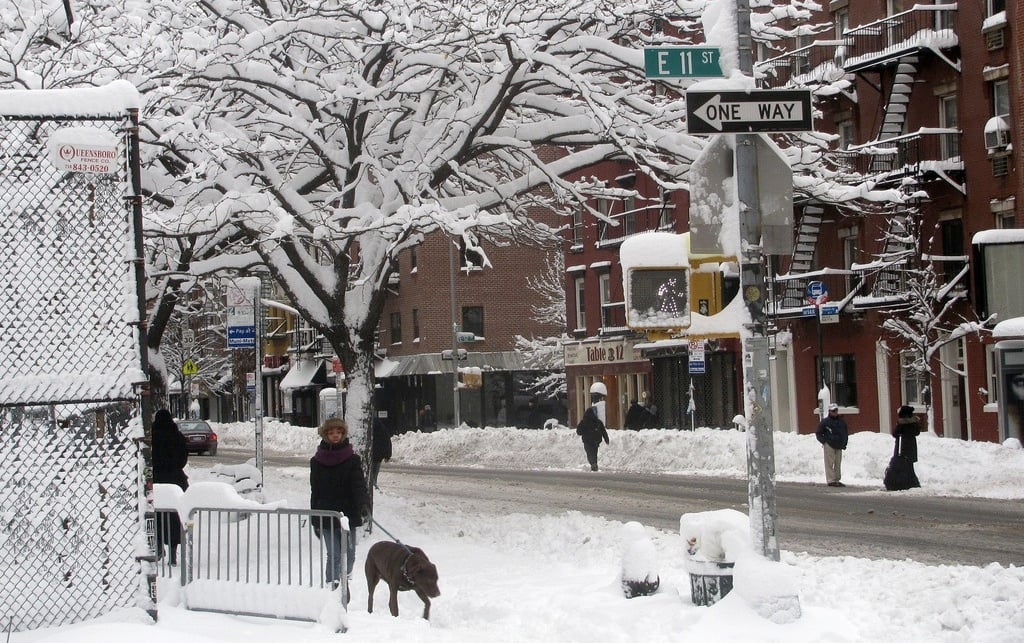‘Tis the season of giving—did you remember to add your food truck to your gift list this year? With temperatures dropping and snow starting to fall, your food truck deserves a little extra special something. Before you head out on the road to meet your legions of hungry fans, make sure your food truck is in tip-top shape with these nine important winterization precautions.
1. Invest in Quality Snow Tires
If the streets in your area are frequently covered in white like a powdered sugar doughnut, you might want to think about switching your truck’s regular tires with snow tires during the winter. Generally, snow tires have special tread patterns that make it easier to avoid slipping and sliding during inclement weather. Because they are usually made with softer rubber than typical tires, they also stay more flexible on even the coldest days. The added flexibility gives you greater traction and better control over your vehicle, which is especially important when you’re negotiating tight turns and working to fit your truck into a tight spot.
Check out websites like TireRack.com, where you can research snow tire traction, learn about performance tests, and find the best tires for your truck. With snow tires giving your truck extra protection all throughout the winter, you’ll always be prepared to meet your loyal customers—freezing rain or shine.
2. Monitor Your Tire Pressure Regularly
Flat tires are the pits. An inconvenience to anyone driving a regular car, a flat can quickly become a devastating loss of business for a food truck owner. That’s not good this time of year. So, during the winter, you need to monitor your tire pressure carefully because cold weather makes the air pressure in your tires dip. You could lose up to 1PSI for every 10 degrees the temperature drops—and when your tires are low on air, you’re much more likely to get a flat. Properly inflated tires also distribute the weight of your truck more effectively and help you get better traction on the road in order to keep you safer during snowy, wet, or foggy driving conditions. Get yourself into the habit of checking your tires first thing each morning when temperatures are often the coldest.
3. Maintain Belts and Hoses
You know how your belt feels a little tighter after Thanksgiving dinner—almost like the leather might burst? Well, cold temperatures can do the same thing to the belts inside your food truck, adding extra strain that makes them likely to stretch and snap. To get your truck ready for a long, chilly winter, have your mechanic look at all of the belts and hoses to make sure everything is still in good shape. If your city is experiencing a particularly cold winter, it’s also a good idea to perform an additional mid-season check in January. A snapped belt might not seem like a major catastrophe, but it’s the type of maintenance problem that can put your truck out of commission until an expensive tow truck or on-site mechanic shows up to get you rolling again.
4. Check or Replace Your Battery
Between the chilly temperatures, busy crowds, and holiday catering events, you’re probably working extra hard during the winter—and your truck’s battery is too. When your engine needs even more power to get started, your battery can easily give out on you on a random, cold morning without any warning. Fortunately, if you have the battery tested ahead of time, you’ll know when it’s starting to run out of steam. Though you can test your battery yourself, you will need special equipment like a voltmeter to do so. However, many auto repair shops offer free battery checks—which is easier and more reassuring for truck owners who don’t have a lot of automotive knowledge.
You should check your battery regularly anyway, but it’s even more important when the weather is cold. Low temperatures slow down the chemical reactions in the battery that give power to your truck. Since your truck needs even more power to get moving during this frigid time of year, adding a low-voltage battery into the mix is a recipe for disaster. If your truck’s battery is starting to get low, buy and install a new one right away so that you don’t get stranded on the side of the road. This isn’t the type of truck repair you should delay.
5. Fill or Replace All Fluids
Just like your tasty pulled pork sandwiches and spicy beef tacos keep your customers going, the fluids in your truck keep it running—and wintertime is the best time to check, fill, and replace them. Though you can probably manage some of these tasks on your own, most food truck owners are more comfortable taking their trucks to a professional for these procedures:
- Make sure your oil is changed regularly. This is especially important during the winter, as cold temperatures can thicken the oil and prevent it from circulating fully throughout the engine. When your engine isn’t lubricated properly, it will have trouble starting in the cold. Ask your mechanic what type of oil you should be using during the winter. If you live in a cold climate, you’ll typically want thinner oil that is less viscous.
- Ask your mechanic to check the antifreeze and water levels in your radiator to make sure they are at the correct ratio to prevent the coolant from freezing. You can buy a small antifreeze tester to check the levels yourself, but you should always have an experienced mechanic recommend the initial ratio rather than trying to determine it yourself.
- Finally, have your mechanic check the transmission fluid, power steering fluid, and brake fluid. You don’t want to be out on the road and suffer a breakdown that could have been easily avoided with such a simple fix!
6. Treat Your Windshield
No matter how hard you try to keep your truck clean throughout the rest of the year, some dirt and grime during the winter is inevitable. Slush, salt, and snow combine to create that icky gray sludge that quickly impairs your visibility and decreases your safety if you don’t treat your windshield properly in advance. To wipe away the toughest dirt and keep the glass looking clear and bright, fill your truck with a heavy-duty brand of windshield wiper fluid and replace the wiper blades. Some wiper fluids contain harsh chemicals that can damage the paint on your truck, so always be sure to read the labels carefully and to test the fluid when you switch to a new brand.
Finally, look over your windshield carefully to make sure there are no small cracks or chips in the glass. When the weather begins to get colder, the change in temperature can put extra pressure on the glass and cause existing cracks to widen. While a repair shop can fill in a small chip pretty easily, a major crack will cost a lot more to fix.
7. Prepare for Frozen Locks
Have you ever rushed out to your truck in the morning, anxious to get inside and start the heater, only to be left out in the cold by a frozen lock? Even something as simple as a frozen door lock can cause a food truck owner a world of trouble. And where a person with a traditional job might be able to call his or her employer to explain the situation and come in late, every minute that you’re not on the street is costing you money.
Be prepared for frozen locks by keeping some de-icer handy. There’s a wide range of de-icing products available, so you may need to try a couple different types to find the one that works best with your truck. Of course, be sure to remember not to keep the de-icer anywhere inside your truck—if the locks freeze, you won’t be able to get to the de-icer that will unfreeze them!
8. Build an Emergency Kit
Every driver should have an emergency kit on board his or her vehicle—but this precaution is even more important during the winter when the weather is harsh, night falls quickly, and accidents occur more frequently.
Your emergency kit should include a first aid kit, a blanket, road flares and reflective triangles, jumper cables, a fire extinguisher, a radio, spare oil and coolant, windshield wiper fluid, some non-perishable snacks and water, and a flashlight. You could also include an extra battery or portable charging system for your cell phone or a gas generator to keep the truck warm if you get stuck. While you’re putting your emergency kit in your truck, take a few extra minutes to check your spare tire and make sure you have all the tools you’ll need to change a tire if you get stuck somewhere.
Though an emergency kit might not seem like a pressing priority right now, you’ll be glad you have one when your truck breaks down in a snowstorm and your cell phone battery is running low. This simple precaution doesn’t take much to put in place, but it can save your life if you get caught in an ugly situation.
9. Plan for Food Storage Alternatives
If you’re used to storing some non-perishables and cooking supplies on the truck, you may need to think again when the winter rolls around. An innocent stack of bottled water could quickly turn into a solid ice block if you leave it on your truck overnight. The same goes for items like cookies, canned goods, and bottles of soda. Each of these items can freeze or harden during bitter temperatures—but when they’ve thawed back to normal temperatures, they won’t taste quite the same.
Instead, plan an alternative solution to store your food and cooking supplies during the winter. You may need to rent space at a commissary or find another temperature-regulated location to store your food. Naturally, be sure to adhere to local laws and health codes in your area before storing food in any location.
Roll On Without Repairs
By following these nine simple tips, your food truck will be ready to warm up hungry holiday crowds all throughout the winter. A little bit of preventative maintenance goes a long way toward avoiding disruptions to your business and keeps your crew rolling through the coldest months of the year. And most importantly, this little bit of tender loving care is just what your food truck asked Santa for this year.
Tell us about a time when a routine maintenance appointment or a preventative check helped you catch a major problem before it grew too big to handle! Share your story in the comments below or on our Facebook page.
image by edenpictures
There is no ads to display, Please add some


